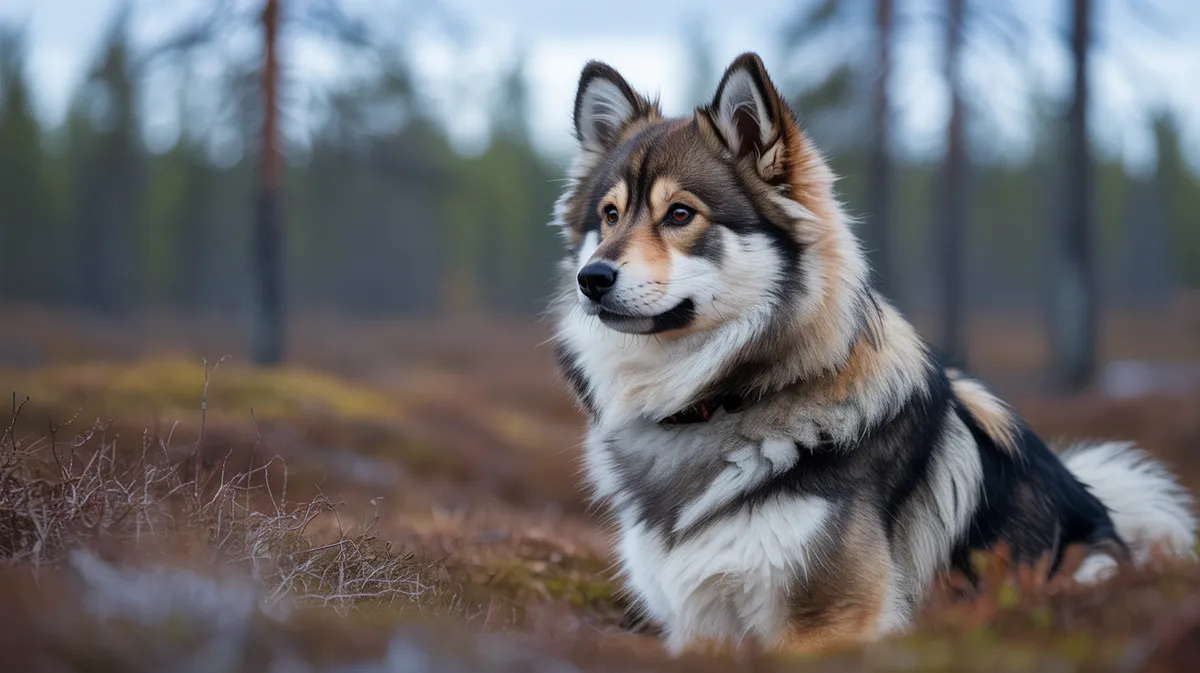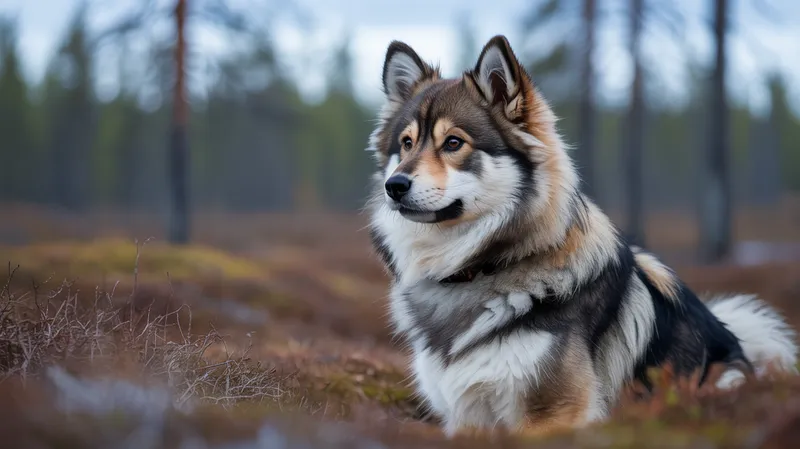
Finnish Lapphund
Canis lupus familiaris

Meet the Finnish Lapphund
The Finnish Lapphund is a hardy, intelligent, and friendly dog breed originating from the Arctic regions of Finland. Traditionally used by the indigenous Sámi people for herding reindeer, this medium-sized breed is known for its thick, weather-resistant double coat and expressive eyes. Finnish Lapphunds are highly adaptable, thriving in cold climates and displaying remarkable agility and stamina. They are renowned for their gentle nature, loyalty, and sociable temperament, making them excellent family companions as well as working dogs.
Classification
Mammal
Habitat
Arctic tundra, boreal forest, and rural settlements
Diet
Omnivore
Lifespan
12-15 years
Conservation
Least Concern
Weight
15-24 kg
📖Fascinating Facts
Reindeer Herder
Finnish Lapphunds have been invaluable to the Sámi people for centuries, helping them herd and manage large groups of reindeer in harsh Arctic conditions.
Weather-Resistant Coat
Their dense, double-layered coat allows them to withstand freezing temperatures and heavy snow, making them well-suited for life in the far north.
Family-Friendly
Known for their gentle and affectionate temperament, Finnish Lapphunds are excellent with children and other pets, making them outstanding family dogs.
📋Detailed Description
The Finnish Lapphund is a robust, medium-sized spitz-type dog, typically weighing between 15–24 kg (33–53 lbs) and standing 41–52 cm (16–20.5 in) at the withers. Its dense, weather-resistant double coat consists of a soft, insulating undercoat and a longer, coarse outer coat, providing exceptional protection against Arctic cold and wet conditions. The breed has a wedge-shaped head, pronounced stop, and expressive, almond-shaped eyes, which contribute to its alert and intelligent appearance. Erect, triangular ears are set well apart, aiding in acute hearing—an advantage for herding and vigilance. The tail is bushy and typically carried curled over the back. Finnish Lapphunds are known for their agility and stamina, traits developed through centuries of working in challenging northern environments. Socially, they are pack-oriented and thrive on companionship, both with humans and other dogs. Their vocalizations, including barking and yodeling, are used for communication during herding and as an alert system. The breed is highly trainable, displaying a keen problem-solving ability and a gentle, patient temperament, making them suitable for families, therapy work, and various canine sports.
💡 Did you know?
The Finnish Lapphund is one of the few dog breeds specifically developed for herding reindeer in the Arctic Circle.
🔬Research & Sources
Wikipedia Summary
The Finnish Lapphund is a hardy, easy going, medium-size breed of Spitz type. Traditionally it has been used for herding reindeer. Although it is one of the most popular dog breeds in its native country, Finland, it is not very numerous outside of the Nordic countries.
Last Modified: 4/19/2025
🎭Behavior & Social Structure
Finnish Lapphunds exhibit a strong herding instinct, characterized by agile movement, quick reflexes, and a tendency to circle and control the movement of livestock, especially reindeer. They are highly social, forming close bonds with their family and displaying a gentle, tolerant demeanor toward children and other pets. Daily routines include bursts of energetic play, mental stimulation, and regular exercise; without adequate activity, they may develop boredom-related behaviors such as digging or barking. Their feeding behavior is typical of domestic dogs, with a preference for high-quality, protein-rich diets. Lapphunds are alert and vocal, often barking to announce visitors or unusual activity, a trait valued in their traditional role as watchdogs. They are generally non-aggressive but may be reserved with strangers, showing a cautious curiosity. Cooperative and eager to please, they respond well to positive reinforcement training methods.
👶Reproduction & Life Cycle
Finnish Lapphunds reach sexual maturity between 8–12 months, though responsible breeding is typically delayed until at least two years of age to ensure physical and behavioral maturity. The breed is monoestrous, with females coming into heat once or twice a year. Mating is usually managed by breeders to maintain genetic diversity and health standards. Gestation lasts approximately 63 days, after which litters of 4–8 puppies are born. The dam provides intensive care during the first three weeks, nursing and cleaning the pups, while breeders may assist with socialization and early neurological stimulation. Weaning begins around 3–4 weeks, and puppies are typically ready for adoption at 8–10 weeks. Finnish Lapphunds are known for their strong maternal instincts and cooperative breeding behavior, sometimes with other females in the household assisting in pup care.
🛡️Adaptations & Survival
The Finnish Lapphund's thick double coat is a key adaptation for surviving subarctic climates, providing insulation against extreme cold and repelling moisture. Their compact, muscular build and well-arched toes allow for efficient movement over snow and rough terrain. The bushy tail can be curled over the nose and face while resting, reducing heat loss. Behavioral adaptations include high intelligence, problem-solving skills, and a strong herding drive, enabling them to manage large, semi-wild reindeer herds with minimal human direction. Their acute senses of hearing and smell are crucial for detecting predators and lost livestock. The breed's sociable and adaptable temperament allows it to function both as a working dog and a companion animal in modern settings.
🎨Cultural Significance
The Finnish Lapphund holds deep cultural significance among the Sámi people, who have relied on these dogs for centuries to manage and protect reindeer herds in the harsh Arctic environment. The breed is celebrated in Finnish folklore and rural traditions as a symbol of resilience, loyalty, and cooperation. In modern Finland, the Lapphund is a national treasure, featured in literature, art, and even postage stamps. Its gentle nature and adaptability have made it a popular family pet and therapy dog, while its skills are showcased in herding trials and canine sports. The breed's preservation is supported by national kennel clubs and cultural organizations, reflecting its enduring role in Finnish heritage.
🔬Recent Research & Discoveries
Recent genetic studies have confirmed the Finnish Lapphund's close relationship to other Nordic spitz breeds, with unique adaptations for cold tolerance and herding behavior. Ongoing research focuses on identifying genetic markers for inherited diseases, particularly PRA and hip dysplasia, to improve breeding outcomes. Behavioral studies highlight the breed's advanced social cognition and problem-solving abilities, making it a model for research on canine intelligence and human-animal communication. Conservation genetics projects are underway to maintain genetic diversity within the breed, especially as its popularity grows internationally. Ethological research continues to document the breed's herding techniques and social dynamics within multi-dog households.
🎥Wildlife Videos

Scandinavia's Hidden Paradises - Nature Documentary
High in the north, in Swedish Lapland, mighty moose feel at home. In the east, near the Russian border, Lake Saimaa in Finland is ...
Get.factual

Tales of Nature - Treasures Of The Deep | Wildlife Documentary
Corsica is an island full of natural treasures. Its beaches are lapped by the Mediterranean, where the sea/bed harbors strange and ...
Best Documentary

The Baltic | Survival in a Pristine Ecosystem | Animal documentary
Welcome to "The Baltic | Survival in a Pristine Ecosystem", a captivating wildlife documentary that transports you to the serene yet ...
WILD NATURE - Nature animal documentary

THE SWISS ALPS | Secrets of the Apex Hunters | Animal documentary
Welcome to the majestic Swiss Alps, a breathtaking wilderness that's home to some of the most extraordinary apex predators on ...
WILD NATURE - Nature animal documentary

Wild Baltic Sea - Between Finland and Sweden | Nature Documentary
Part 3 of the Wild Baltic Sea Documentary Series takes us to the Bay of Bothnia. Remote, wild, and largely unexplored, this is the ...
Get.factual

Land of Ice and Snow (Full Episode) | Wild Nordic
As seen by the Viking gods, the fabled wildernesses of Norway, Finland and Sweden are revealed from the skies above. Watch ...
Nat Geo Animals
🌍Habitat Information
The Finnish Lapphund typically inhabits Arctic tundra, boreal forest, and rural settlements environments. Finnish Lapphunds have adapted to their environments with specialized features and behaviors.
Primary Habitat:
Arctic tundra, boreal forest, and rural settlements
More detailed habitat information will be available soon.
🛡️Conservation Status
The Finnish Lapphund is currently classified as Least Concern. Conservation efforts are crucial for preserving this species for future generations.
Common Threats:
- 🏠Habitat loss and fragmentation
- 🌡️Climate change impacts
- 🎯Hunting and poaching
- 🏭Human-wildlife conflict
⚠️Threats & Conservation Challenges
While the Finnish Lapphund is not currently at risk and is classified as 'Least Concern,' the breed faces challenges related to genetic bottlenecks due to its relatively small population outside Finland and the Nordic countries. Urbanization and the decline of traditional reindeer herding have reduced the demand for working Lapphunds, shifting the breed's role toward companionship and sport. Inbreeding and hereditary health issues, such as progressive retinal atrophy (PRA) and hip dysplasia, are monitored through breed clubs and health registries. Responsible breeding practices and genetic testing are essential to maintaining long-term breed health. Climate change and habitat alteration may indirectly affect the breed by impacting traditional herding practices.
🔬Scientific Classification
Scientific Name
Canis lupus familiaris
Classification Hierarchy
🔍 About Taxonomic Classification
Taxonomic classification is a hierarchical system used by scientists to classify and organize living organisms based on shared characteristics and evolutionary relationships.
The system moves from broad categories (Kingdom) to increasingly specific ones, with each animal's scientific name typically consisting of its Genus and species.
📝Community Notes
Share your observations and insights about the Finnish Lapphund with our community of wildlife enthusiasts.
Join Our Community
Sign in to share your observations and connect with fellow wildlife enthusiasts.
Sign In to ContributeNo community notes yet
Be the first to share your observations about the Finnish Lapphund!
Explore Finnish Lapphund
Select a tab above to learn more about this amazing animal.
📸Photo Gallery
No photos available for this animal yet.
🌟Discover More Wildlife
Continue your journey of discovery with more fascinating animals from our database
